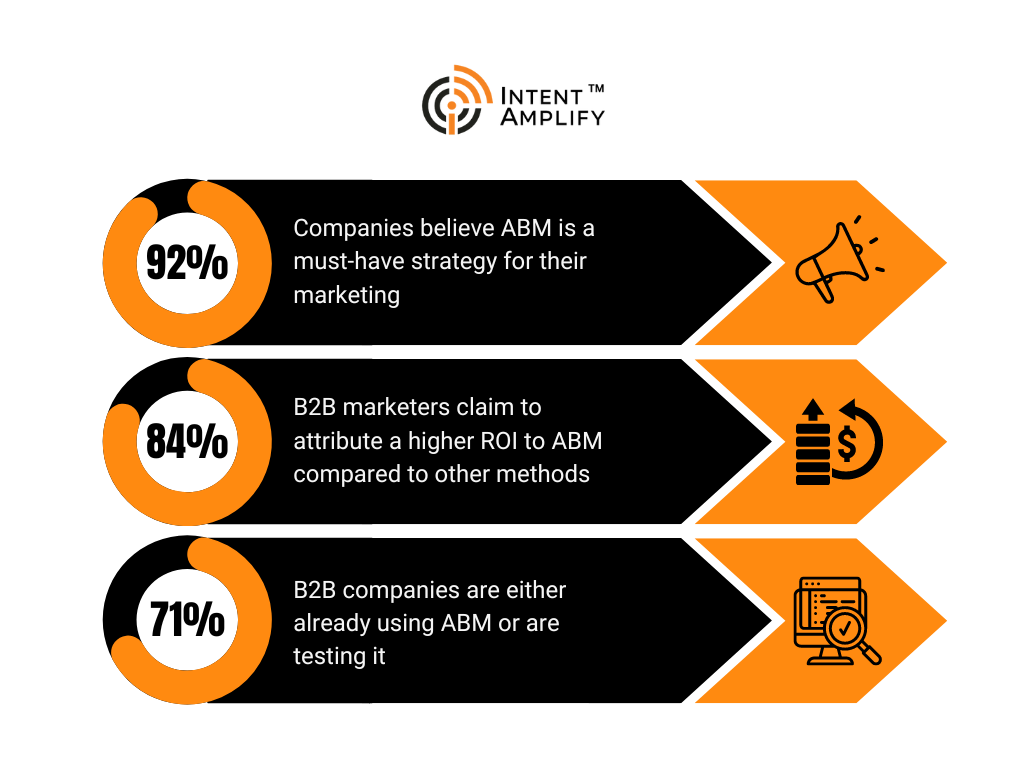
Driving Revenue With ABM: How Target Marketing Maximizes ROI
- Last updated on: April 1, 2024
The increasing popularity of ABM (Revenue with ABM) is well-founded: strategically directing resources toward targeting and converting specific accounts yields positive results.
According to 80% of marketers monitoring ROI, ABM consistently surpasses other marketing strategies, often by a considerable margin.
Account-based marketing (ABM) drives revenue and achieves business goals. It provides a tailored approach for high-value accounts. This strategy focuses on targeting specific companies rather than a broad audience. ABM aligns marketing and sales efforts to increase effectiveness.
In this blog post, we’ll explore how ABM can drive revenue growth and provide actionable insights for implementing an effective ABM strategy.
Understanding Account-Based Marketing (ABM)
What is ABM?
Account-based marketing or ABM is a marketing technique that combines marketing and sales expertise to target specific “accounts” or individuals. Instead of casting a net on a large surface, ABM decides the target audience and specifically directs all energies to these selected accounts only.
The accounts are carefully designed by drafting an ICP (Ideal customer profile) and mapping the offerings to suit their individual tastes. It further takes into consideration factors such as the stage at which the buyer is and crafts messaging accordingly. This greatly increases the chances of conversion while improving the ROI.
This personalized approach allows for deeper engagement and relationship-building, ultimately driving revenue growth by maximizing the value of each customer relationship. Let us now understand how ABM can help drive revenue for businesses.
Identifying High-Value Accounts
High-value accounts are those customers who have the potential to generate significant revenue for the company. The first step in driving revenue using the ABM strategy is by identifying the right target accounts.
But how do you identify these accounts?
Identifying high-value accounts that can drive revenue requires you to turn to your sales funnel and assess it carefully to determine the best-fitting prospects for your offering. You can up-sell, cross-sell, or offer additional products to your recently converted clients.
For new customers who match your ICP, you can gather leads from trade shows and buy buyer-intent data from lead generation companies. Consequently, you can leverage databases of B2B lead generation companies by leveraging their services.
Additionally, look for organizations that align with your product or service. They should have a clear need or pain point your solution can address. Ensure they have the resources to make a significant purchase.
Building Personalized Campaigns
After having identified your target accounts, it’s time to create personalized campaigns tailored to each account’s specific needs and preferences. This may involve crafting customized messaging, developing personalized content, and leveraging channels the target organization prefers.
If you want your ABM to drive revenue for you, speak directly to the challenges and goals of each account. This way you can capture their attention and demonstrate the unique value proposition of your offering.

Leveraging Data and Analytics
To measure the output of any marketing strategy, you need data. Hence, data-driven insights are crucial for the success of an ABM strategy as well. You can do that by identifying key performance indicators (KPIs) for your ABM strategy.
Here are some examples of KPIs that you might consider for your ABM strategy:
- Engagement of Target Accounts: This metric assesses the level of involvement your target accounts have with your brand. It encompasses indicators like website traffic, email interaction (opens and clicks), and engagement on social media platforms.
- Conversion Rate: This KPI quantifies the proportion of target accounts that successfully complete a desired action, such as submitting a form or making a purchase.
- Customer Lifetime Value (CLV): CLV measures the total revenue generated by a customer throughout their relationship with your brand, offering insights into long-term profitability and customer retention.
- Net Promoter Score (NPS): NPS evaluates the likelihood of customers recommending your brand to others, serving as an indicator of customer satisfaction and loyalty.
- Cost per Acquisition (CPA): This metric calculates the expenses incurred to acquire a new customer through your ABM initiatives, providing clarity on the efficiency and effectiveness of your marketing investments.
Use data about the account’s industry, size, location, and other characteristics. Create customized marketing materials. Personalize email campaigns and targeted ads. Optimize the timing and frequency of outreach. Predictive analytics can identify potential target accounts that are most likely to be interested in a company’s products or services.
Use tools like customer relationship management (CRM) software, website analytics, and marketing automation platforms to gather and analyze data, allowing you to refine your approach and optimize results over time. Using data and analytics to measure output, you can effectively drive revenue with your ABM efforts.
Aligning Sales and Marketing Efforts
- Improvements in conversion rates are observed when both sales and marketing jointly manage lead nurturing and incubation.
- Businesses boasting tightly integrated sales and marketing units tend to enjoy a 36% increase in customer retention rates and a 38% surge in sales win rates.
In a traditional broad-based marketing strategy, the marketing team generates leads through various channels like advertising, email campaigns, and social media. Once these leads are acquired, the sales team takes over to convert them into customers.
However, in Account-Based Marketing (ABM), there’s a fundamental shift where sales and marketing collaborate closely throughout the entire process. This alignment, though crucial, doesn’t happen overnight. It requires strategic planning and concerted effort.
Nurturing Relationships
Successful ABM isn’t just about acquiring new customers; it’s also about nurturing existing relationships and maximizing customer lifetime value. Be proactive in engaging with customers. Offer ongoing support and personalized recommendations. Look for chances to upsell or cross-sell additional products or services. Deliver exceptional experiences and consistently add value. This will build loyalty and encourage repeat business from key accounts.
Measuring ROI and Iterating
Measuring ROI is crucial for assessing your ABM strategy’s success. Track KPIs like account engagement, pipeline velocity, and revenue from target accounts. Analyze this data to see what works and what doesn’t. Use these insights to adjust and improve your ABM approach over time.
Account-based marketing offers a powerful framework for driving revenue and enabling organizations to focus resources on high-value accounts and deliver personalized experiences. By identifying target accounts, crafting personalized campaigns, leveraging data and analytics, aligning sales and marketing efforts, nurturing relationships, and measuring ROI, businesses can harness the power of ABM to unlock new revenue opportunities and drive sustainable growth in the long term.




